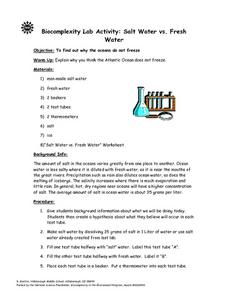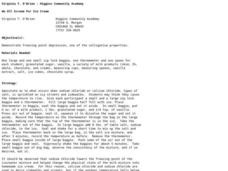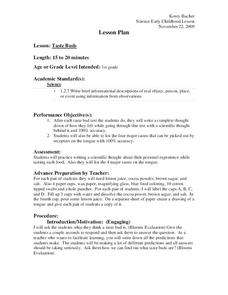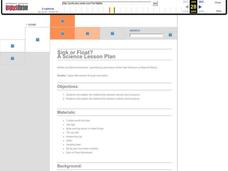Curated OER
Antarctica: Effects of Salinity on Icebergs
Students investigate the effects of salinity on icebergs. In this hands on lesson plan, students design and conduct an investigation into how the amount of salt in ice affects its buoyancy.
Curated OER
Salt Water vs. Fresh Water
Middle schoolers explore why the oceans do not freeze. They explain why they think the Atlantic Ocean does not freeze. Students are given background information about what they are doing. They create a hypothesis about what they...
Curated OER
We All Scream for Ice Cream
Young scholars investigate the freezing point depression of water while making ice cream. In this colligative properties lesson plan, students make ice cream using ice, salt and water to freeze milk and sugar. They measure the...
Curated OER
EASY (AND CHEAP) CRYSTAL GROWING
Students grow salt crystals by making a saturated solution of table salt and let the solution sit around and evaporate.
Curated OER
Soil pH Effect on Germination of Specific Weeds
Students collect weed seeds from three varieties of weeds (knapweed, thistle, or toadflax, for example they may choose others in addition to the spotted knapweed.) They sterilize soil for thirty containers, plant seeds in sterile soil,...
Curated OER
How Do You Make A Tornado?
Students create a tornado in a bottle. In this climate and weather lesson, students review basic information about tornadoes and thunderstorms. Students make a tornado in a bottle and write about what they learned from the project....
Curated OER
Physical and Chemical Changes
Students investigate chemical and physical changes. In this physical and chemical change lesson plan, students perform 3 experiments in the lab to observe changes in matter. They determine that no new substances are formed in physical...
Curated OER
Hunting for Aqueous Solutions
For this aqueous solutions worksheet, students will conduct an experiment to determine the solubility of different common kitchen items. Students then complete 3 short answer questions.
Curated OER
Sense of Taste
Students swab different sections of the tongue to identify taste buds. In this sense of taste instructional activity, students make predictions and conduct an experiment. Students experiment with a variety of flavors and discuss results...
Curated OER
Wonders of Weather
Students investigate weather disasters by creating a virtual tornado. In this wild weather lesson, students define a vortex and describe how a vortex keeps a tornado moving and causing damage. Students utilize salt, detergent, water,...
Curated OER
An Oceanographic Proxy
Students conduct experiments on a sample of sea water. In this oceanography lesson, students inquire how conductivity is used to approximate the salinity ocean water. Students construct their own conductivity meters and test solutions...
Curated OER
Understanding pH, Alkalinity, and Hardness
Students comprehend the interactions of pH, alkalinity, hardness, and carbon dioxide in aquaculture water. They read the SRAC fact sheet number 464 "Interactions of pH, Carbon Dioxide, Alkalintiy and Hardness in Fish Ponds." Students...
Curated OER
Reading: Taking Care of the Common Cold
In this reading for information worksheet, learners read a one page passage from the Mayo Clinic about taking care of the common cold. Students answer 8 multiple choice questions about the information.
Curated OER
Taste Buds
First graders taste a variety of items and record a full sentence about the way they taste. In this taste buds lesson, 1st graders predict and then taste various items. Students draw a picture of the tongue and show the part that...
Curated OER
Colligative Properties and Chemical Equilibria
For this colligative properties and chemical equilibria worksheet, students answer twenty questions including ranking solutions base on their colligative properties and determining what must happen to a reaction to reach equilibrium.
Curated OER
Rusting-A Form of Oxidation
Young scholars conduct an experiment to observe oxidation. In this chemistry lesson, students explain how rusting happens. They rank metals according to their conductivity.
Curated OER
Sink or Float?
Students analyze the relationship between density, buoyancy, and salinity. In this chemical properties lesson plan, students read a background activity for the lesson plan and experiments to the topics. Students discuss the questions and...
Curated OER
Matter and Change
In this matter and change activity, learners answer 24 questions on topics such as elements, compounds, mixtures and chemical reactions. Students answer questions about the properties of matter such as their physical state and shape. In...
Curated OER
Displacement Reactions and Acid/Base Reactions
In this chemical reactions instructional activity, students review the solubility rules for common salts. Students determine the molecular equation, ionic equation, and net ionic equation for specific reactions. Students calculate moles...
Curated OER
Molarity
For this molarity worksheet, students calculate the molarity of 13 different molecules. Students also determine the concentration of given solutions. This worksheet has 19 word problems.
Curated OER
Ethyl Alcohol
In this ethyl alcohol learning exercise, students read about the characteristics of ethanol including the effects it has on the body when ingested and digested. This learning exercise has 2 short answer questions.
Curated OER
Saltwater Science
Students conduct an experiment that shows them how salt water allows things to float. In this salt water lesson plan, students mix ingredients together to create salt water and observe how it makes the oceans dense. They then interpret...
Curated OER
Entropy
In this entropy learning exercise, students review the Second Law of Thermodynamics and explore how entropy changes. This learning exercise has 5 word problems.
Curated OER
Characteristics of Crystals
In this crystals worksheet, students complete a graphic organizer by filling in the characteristics of the different crystal types including melting/boiling point and electrical conductivity.

























